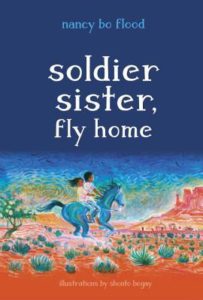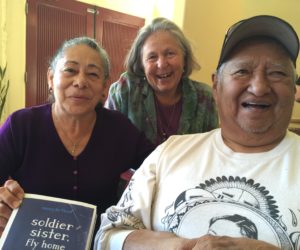Today, we want to celebrate our own Nancy Bo Flood’s newest book, Soldier Sister, Fly Home! The book follows in the footsteps of many of Nancy’s books, exploring themes related to war, as well as setting in the Navajo culture of Arizona. Publishers’ Weekly gave it a starred review, and described it this way: “The book successfully presents Tess’s shifting emotions as she grapples with the vicissitudes of a close sibling relationship, revels in her daily runs in the desert, and struggles to bond with a temperamental horse. Navajo traditions, ceremonies, and family relationships are described with gentle reverence; even the butchering of an ewe is depicted as a beautiful act….This quietly moving story of Tess’s growing maturity as she searches for her cultural identity resounds with authenticity.”
- You’ve written quite a lot about Navajo culture in Arizona. How and when did your love for First Nations and, in particular, the Navajo people emerge?
When our children were growing up, our family lived in western Colorado. Every spring we left the snow and cold of the Rocky Mountains and headed to the desert. My first falling in love was with the stark beauty, immensity, and ruggedness of the desert. As I learned about the people for whom the desert is home, I wanted to learn more. When we had the opportunity in 2001, my husband and I accepted the invitation to work on the Navajo Nation, Bill as a pediatrician and myself as a teacher for the Dine’ (Navajo) College. As we worked side by side with our Navajo peers, our interest and respect for their culture and friendships with individuals grew. A core value for Navajo is to “walk in beauty,” to walk in harmony with all. Oh, that we would all try to do that!
2. This is a book about belonging and, oddly, about death. Can you talk more about what death means within the context of your book?
An important part of understanding a culture is sharing their grieving, mourning with them, honoring their losses. I was teaching in Tuba City for Dine’ College.. The war in Iraq had begun. Many of my students were enlisting. The entire town was aware that Lori Piestewa, a recent Tuba City High School graduate, was missing in action. Candles were lit, prayers were said, “to show Lori the way home.” But Lori did not survive. Lori Piestewa became the first Native American woman to die in combat on foreign soil. A memorial was held at the high school. Everyone was invited. Hundreds attended. I sat with Navajo, Hopi, Mexican-American, and Anglo, people who often don’t come together. People put aside their differences and distrust. They gathered together to honor the life and death of this young woman.
3. Some people in the children’s lit community have criticized your decision to reference an actual historical person in this narrative. Though the book is not about Lori Piestewa, the first Native American woman to die in combat while serving in the U.S. military, it opens with Lori’s memorial celebrated by the larger community in which she lived, and we learn quickly that Lori was good friends with Tess’s sister, who has also just joined the military. Can you talk about your choice to include a real person in this book, even if peripherally? What is a writer’s responsibility when choosing to do this?
As the story of Soldier Sister evolved I knew that I wanted to dedicate the book to Lori and to all women who serve in the military. I also knew it was my responsibility not only to do the research to “get it right”, but also to ask Lori’s family. The Piestewa family welcomed me. They were pleased that the book would honor their daughter. After reading an early version of the book, Percy Piestewa, Lori’s mother, phoned and said, “The book is awesome. Beautiful. I like it very much.” Then she said, “There is something I would like changed. You wrote that Lori was a member of the Hopi tribe, which is true, but Lori was mixed-blood. She was Hopi and Mexican-American. I would like that included.” And then Percy continued, “A wonderful part of this story that meant a lot to me is that the two sisters, they too were mixed-blood. Lori had trouble with other students at school. Often it was hard for her like it was for Tess and Gabby.”
Just this month since the book’s release, I discovered another reason I am happy the book honors Lori and that her story is part of Soldier Sister, Fly Home. As part of my author visits to Navajo Nation schools I talked with students about why I wrote this book. I asked how many knew: “Who is Lori Piestewa?” Few students raised their hands. They were interested and proud to learn about her. Then I asked, “how many have family members deployed to Iraq or Afghanistan?” Many raised their hands. We talked about how Tess felt when her sister was deployed. Students were eager to share how they felt – scared, proud, angry, a whole mix of feelings. Students listened to each other, shared even more. That is the gift of story – connecting with each other and with ourselves.
- Tess is part-white, part-Navajo. Her grandmother tells her she needs to embrace both sides of herself, that she doesn’t need to choose one or the other. While not all teenagers are bi-racial or bi-cultural in this same way, many teenagers do struggle internally and feel divided within–perhaps due to conflicting identities, perhaps due to conflicting values or conflicting desires. How do you think Tess’s story can address their needs?
Soldier Sister, Fly Home is about walking the bridge between two worlds, Navajo and Anglo. In Soldier Sister, the two sisters, Tess and Gaby, are bi-racial. They walk this bridge daily, between cultural worlds and also between generation worlds. My hope is that readers will see through Tess and Gaby’ eyes – feel encouraged learning that others experience similar frustrations, shunning, and prejudice. I also hope readers learn from Tess’s journey as she searches to discover–Who am I? Who do I want to be? Like Tess, I hope readers will find within themselves, their families, and culture, what gives them strength.
- What are you working on right now?
I’m working on several projects, nonfiction, poetry, fiction, even a picture book. I like being able to switch between being sometimes in this world, and sometimes in an imagined world. Alma Flor Ada, Isabel Campoy, and I are putting together a poetry anthology: Poems of Protest and Peace. I’m tackling an “umpteenth” revision of a historical novel, Prisoners of War, in which Maddie fights to stay connected with her imprisoned father, a Vietnam Vet.
7. What are you currently reading (or what is on your nightstand)?
Two amazing new nonfiction books: Sachiko, a Nagasaki Bomb Survivor’s Story by Caren Stelson, and Vietnam by Russell Freedmann, an unforgettable novel, Playing for the Devil’s Fire by Philippe Diederich, plus a stack of picture books (I love them!), including: Look Up! By Jung Jin-Ho (what a surprise), Be the Change, a Grandfather Gandhi Story, by Arun Gandhi and Bethany Hegedus, illustrated by Evan Turk, and The Sound of All Things by Myron Uhlberg, the son of deaf parents, illustrated by Ted Papoulas.


1 comment for “Nancy Bo Flood on Soldier Sister, Fly Home”